
MIT Laboratory for Nuclear Science: Jessica Fry Named to Forbes 30 Under 30
Jessica Fry, an MIT physics Ph.D. candidate in Lindley Winslow’s lab within the Laboratory for Nuclear Science, has been named to the Forbes 30 Under 30 – Science list for her innovative work developing experimental devices to search for dark matter.December 11, 2025

25 Years of Research in Space
MIT astronauts aboard the International Space Station—and the MIT researchers who have sent up experiments—have advanced our understanding of science, space, and the universe.October 21, 2025
Photo Credit: Expedition 27 crew member Paolo Nespoli from the Soyuz TMA-20 on May 24, 2011

With a New Molecule-Based Method, Physicists Peer Inside an Atom’s Nucleus
An alternative to massive particle colliders, the approach could reveal insights into the universe’s starting ingredients.October 23, 2025
Photo Credit: Courtesy of the researchers; edited by MIT News

Could a Primordial Black Hole’s last Burst Explain a Mysteriously Energetic Neutrino?
If a new proposal by MIT physicists bears out, the recent detection of a record-setting neutrino could be the first evidence of elusive Hawking radiation.September 18, 2025
Photo Credit: Toby Gleason-Kaiser, using SpaceEngine @ Cosmographic Software LLC.

Junior Peña, Neutrino Hunter
At MIT’s Formaggio Lab, Peña’s work may help researchers pinpoint the elusive particle’s mass— and refine the fundamental laws of physics in the process.August 26, 2025
Photo Credit: Jessica Chomik-Morales, SM ’25

Physicists Devise an Idea for Lasers that Shoot Beams of Neutrinos
Super-cooling radioactive atoms could produce a laser-like neutrino beam, offering a new way to study these ghostly particles — and possibly a new form of communication.September 8, 2025
Photo Credit: Jose-Luis Olivares, MIT; iStock

New Particle Detector Passes the “Standard Candle” Test
The sPHENIX detector is the newest experiment at Brookhaven National Laboratory’s Relativistic Heavy Ion Collider (RHIC) and is designed to precisely measure products of high-speed particle collisions. From the aftermath, scientists hope to reconstruct the properties of quark-gluon plasma (QGP) — a white-hot soup of subatomic particles known as quarks and gluons that is thought to have sprung into existence in the few microseconds following the Big Bang.September 2, 2025
Photo Credit: Courtesy of Brookhaven National Laboratory

The MIT Center for Theoretical Physics – A Leinweber Institute will receive a $20 million gift from the Leinweber Foundation
MIT has received a $20 million gift from the Leinweber Foundation, alongside a $5 million commitment from the School of Science, to enhance theoretical physics research and education. This funding will establish the MIT Center for Theoretical Physics – A Leinweber Institute, supporting postdoctoral fellowships and fostering collaboration within a network of leading research institutions.May 28, 2025
Photo Credit: Peter Vanderwarker

Krishna Rajagopal receives the 2025 Arthur C. Smith Award
Krishna Rajagopal, the William A. M. Burden Professor of Physics, has been selected by the Undergraduate Advising Center Awards Committee to receive the Arthur C. Smith Award. The Arthur C. Smith award is presented to a member of the MIT faculty for meaningful contributions and devotion to undergraduate student life and learning at MIT. John Winston Belcher, the Class of 1922 Professor of Physics, Emeritus (1971-2021), also received this award in 2012.May 8, 2025
Photo Credit: Courtesy of Department of Physics
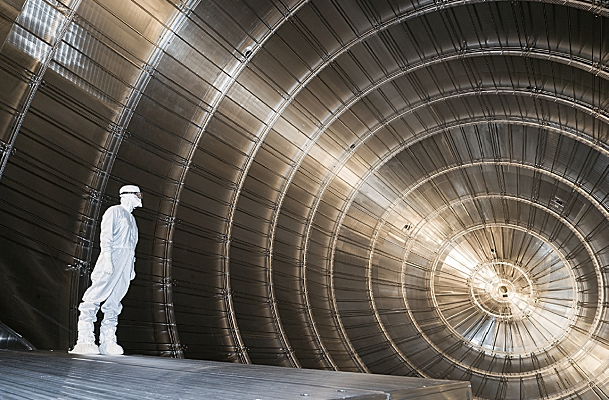
Closing the gap in the neutrino mass
A new report in Science, discusses a significant advancement in measuring the mass of neutrinos, elusive subatomic particles that are fundamental to our understanding of the universe. An international team of scientists, including LNS's Joe Formaggio and his group, and collaborators on the Karlsruhe Tritium Neutrino Experiment (KATRIN) at Germany's Karlsruhe Institute of Technology, has established a new upper limit on the neutrino's mass .April 10, 2025
Photo Credit: KATRIN Collaboration

MIT Professor Washington Taylor interview about CO2 removal
A new report by the American Physical Society and lead by MIT physicist, Washington Taylor, provides an overview of the major experimental CDR approaches and determines their fundamental physical limits. The report focuses on methods that have the biggest potential for removing carbon dioxide, at the scale of gigatons per year, which is the magnitude that would be required to have a climate-stabilizing impact.February 6, 2025
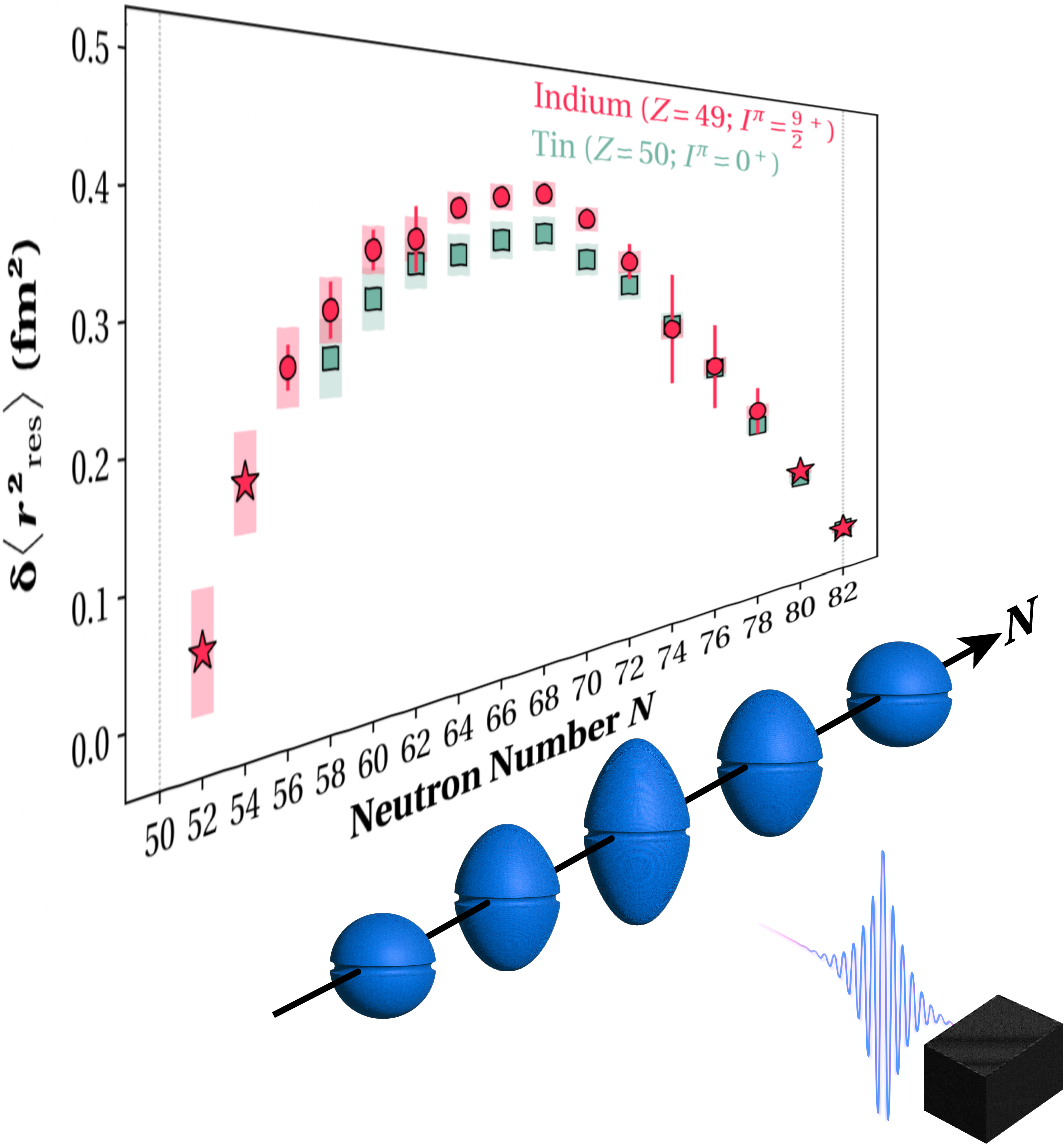
Results Reveal Strong Evidence For the Doubly Magic Nature of Sn-100
LNS scientist testing the possible doubly magic nature of Tin-100, study the electromagnetic properties of Indium isotopes. Scientists are closing in on a major cornerstone of nuclear physics, Tin-100.January 31, 2025
ARCHIVES
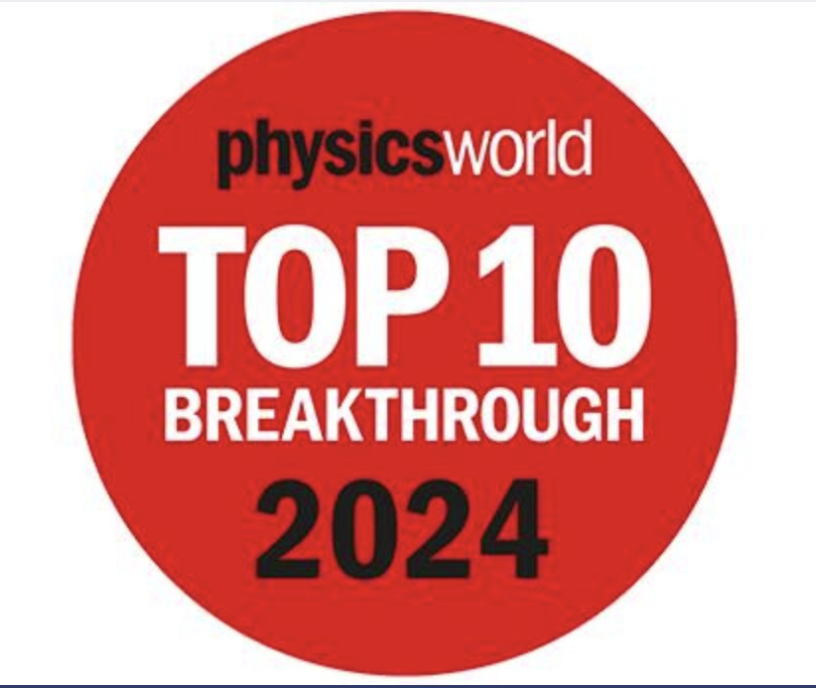
Physics World’s Top 10 Breakthroughs of the Year for 2024
Physics World has selected two research advances by MIT physicists for its Top 10 Breakthroughs of the Year for 2024, reports Hamish Johnston for Physics World. Graduate student Andrew Denniston, his advisor Prof. Or Hen, and his colleagues were honored for their work “being the first to unify two distinct descriptions of atomic nuclei,” which Johnston describes as a “major step forward in our understanding of nuclear structure and strong interactions.” MIT researchers were also featured for their work demonstrating quantum error correction on an atomic processor with 48 logical qubits, making it “far more likely that quantum computers will become practical problem-solving machines.”December 12, 2024
.jpg)
MIT Professor Tracy Slatyer to Receive Jon C. Graff, Ph.D. Prize for Excellence in Science Communication
Society for Science today announced that Tracy Slatyer, Ph.D., a theoretical physics professor at Massachusetts Institute of Technology (MIT), has won the $1,000 Jon C. Graff, Ph.D. Prize for Excellence in Science CommunicationNovember 14, 2024
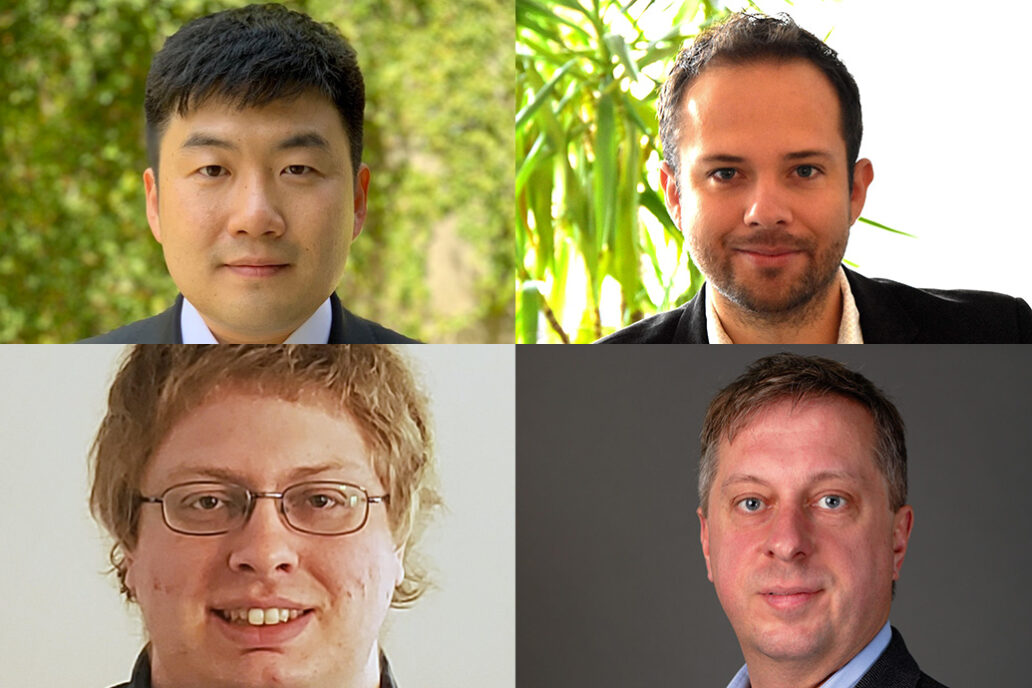
Four physics faculty named to professorships
The School of Science appointed four Department of Physics faculty to named professorships. The faculty members selected for these positions receive additional support to pursue their research and develop their careers.November 14, 2024
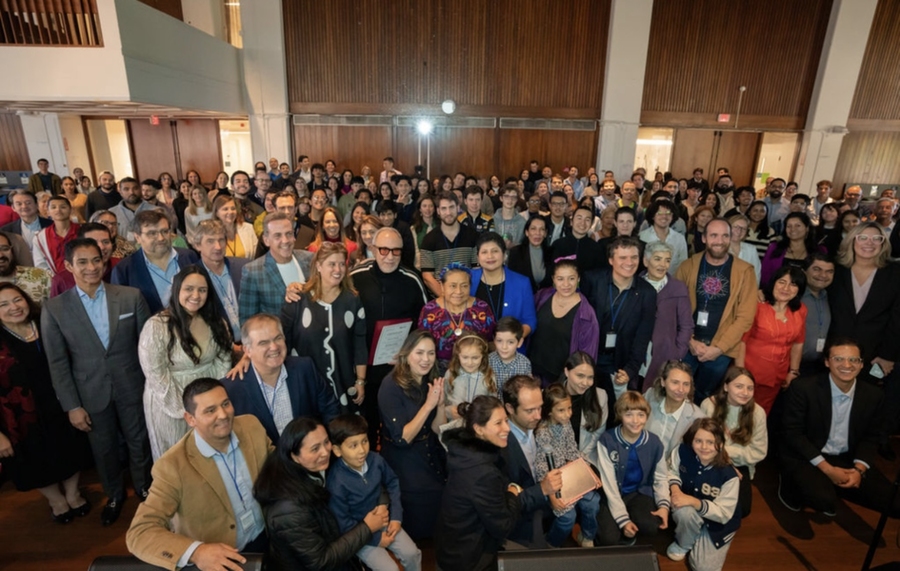
Bridging Talents and Opportunities Forum connects high school and college students with STEAM leaders and resources
Event at MIT featured an array of national and international speakers including a Nobel laureate, leaders in industry, and in entertainment.November 4, 2024
Photo Credit: Danny Ortiz
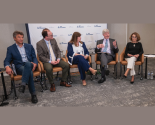
Physics, AI, and the future of discovery
Leaders from industry, government, and academia, including our own Jesse Thaler who is both a CTP and Physics professor and Director of IAIFI, discuss the potential impact of AI on physics—including neutrinos, exoplanets, term papers, outreach, and workforce gaps—and of physics on AI.November 1, 2024
From left: Evgeni Gousev, Jesse Thaler, Valerie Browning, Walter Copan, and France Córdova, moderator.
Photo Credit: ERIC STOCKLIN
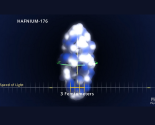
Video: Visualizing the nucleus
Physicists Rolf Ent from Jefferson Lab, and Richard Milner from MIT, together with animator James LaPlante from Sputnik Animation, have created a 10 minute video that includes new animations of the atomic nucleus.October 23, 2024
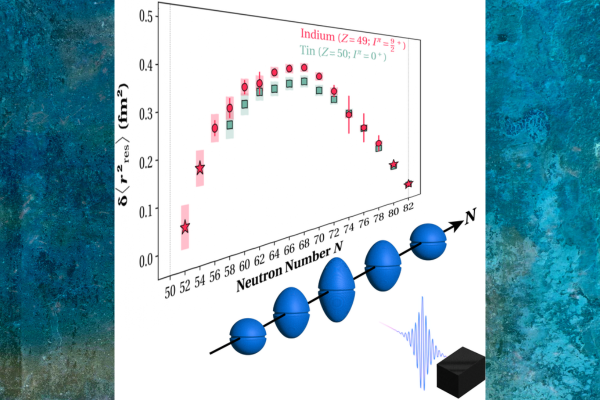
Electromagnetic properties of indium isotopes illuminate the doubly magic character of 100Sn
We used precision laser spectroscopy to study independent nuclear observables of elusive, short-lived indium isotopes for the first time. Clear parabolic trends in the measured nuclear deviation from spherical shape showed minima at very specific nuclear configurations, also known as magic numbers. Our results were compared to state-of-the-art theoretical predictions to confirm the predicted enhanced stability of one of the critical isotopes in nuclear physics, 100SnSeptember 30, 2024

10 early-career scientists tackling some of the biggest problems of today
Tracy Slatyer named 10 early-career scientists tackling some of the biggest problems of today by .September 24, 2024

MIT physicists use precision with the CMS detector to resolve the puzzle of the W boson mass
Joshua Bendavid, a research scientist from the Massachusetts Institute of Technology (MIT, PhD 2013), presented an exciting breakthrough by the CMS experiment at the Large Hadron Collider (LHC).September 17, 2024
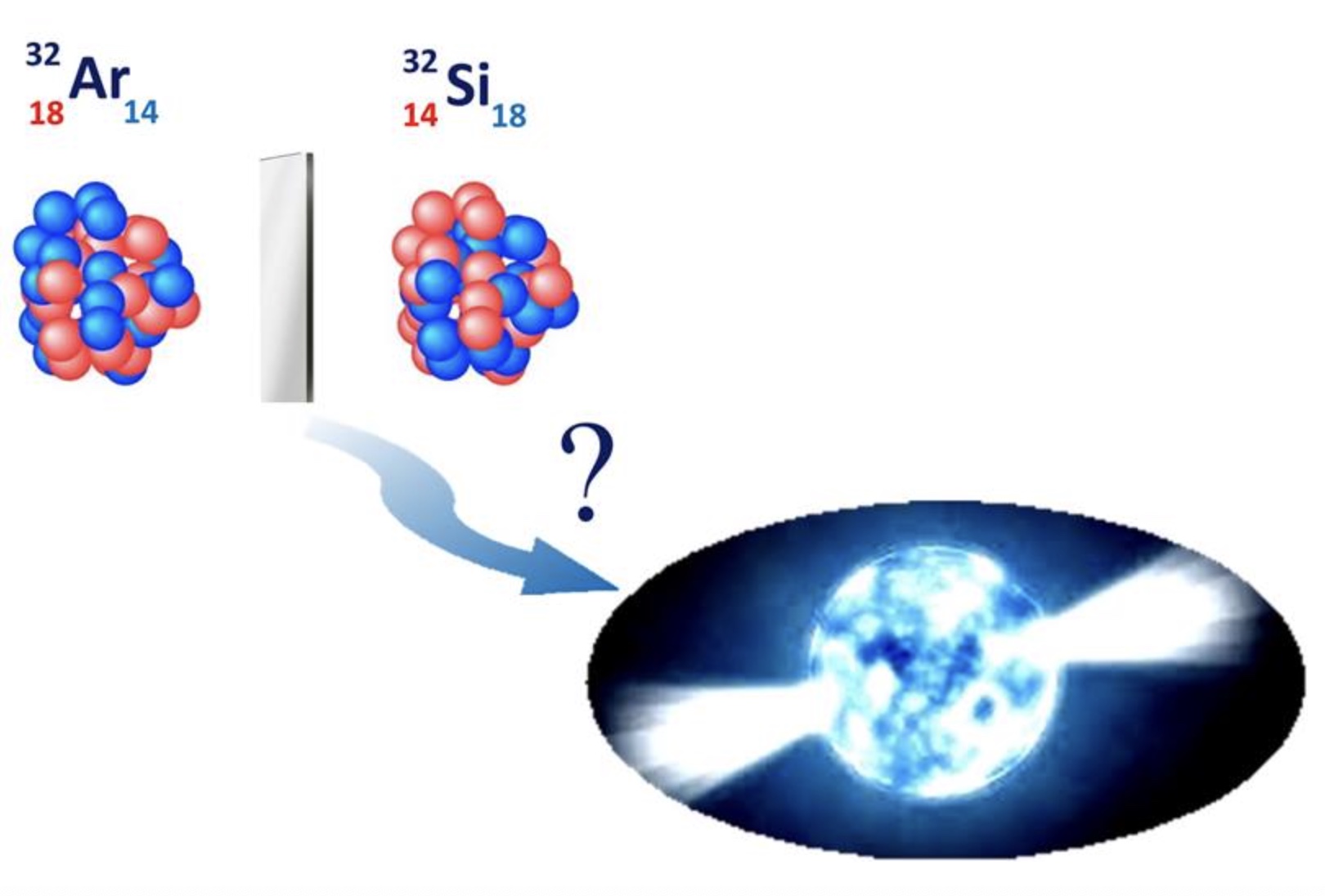
“Mirror” Nuclei Help Connect Nuclear Theory and Neutron Stars
Charge radii measurements of silicon isotopes test nuclear theories and guide descriptions of nuclear matter.
August 9, 2024
Image courtesy of Ronald Garcia/Dean Lee

Exotic black holes could be a byproduct of dark matter
In the first quintillionth of a second, the universe may have sprouted microscopic black holes with enormous amounts of nuclear charge, MIT physicists propose.
June 6, 2024
Image by Kaća Bradonjić

Precision Measurements of Radioactive Molecules for Fundamental Physics
Using lasers with precisely tuned frequency, λ, physicists control rotational states of radium monofluoride molecules and excite specific rotational levels, characterized by the quantum number, J. These excitations manifest as sharp spectral peaks.
May 22, 2024
Image courtesy of Silviu-Marian Udrescu

Tracy Slatyer named 2024-25 Harvard Radcliffe Institute Fellow
Harvard Radcliffe Institute today announced its historic 25th anniversary class of fellows, marking a quarter century of pathbreaking interdisciplinary study.
May 10, 2024

Nuclear Charge Radii of Silicon Isotopes
This experiment was performed using long-lived silicon isotopes at BECOLA, prior to the installation of the new Resonance Ionization Spectroscopy Experiment (RISE). It did not involve the FRIB beam + RISE yet, however, it shows the potential of using harvested isotopes with our precision laser spectroscopy techniques. Our first experiment using both FRIB and RISE is scheduled for May.
April 16, 2024
Image: Courtesy of Facility for Rare Isotope Beams (FRIB)

Three from MIT awarded 2024 Guggenheim Fellowships
MIT professors Roger Levy, Tracy Slatyer, and Martin Wainwright appointed to the 2024 class of “trail-blazing fellows.”
April 26, 2024
Photo: Courtesy of the faculty

Twenty-three MIT faculty honored as "Committed to Caring" for 2023-25
The honor recognizes professors for their outstanding mentorship of graduate students.
April 22, 2024
Photo: Courtesy of honorees

Physicist Netta Engelhardt is searching black holes for universal truths
She says one question drives her work: “Which pillars of gravitational physics are just not true?”
April 9, 2024
Photo: Adam Glanzman

Eight from MIT named 2024 Sloan Research Fellows
Fellows honored for creativity, innovation, and research accomplishments.
February 29, 2024

Physicists Remotely Sense Radioactive Decay to Probe Fundamental Forces and Particles
The Project 8 and He6-CRES collaborations use a new technique to set an upper limit on neutrino mass and prepare to test the nature of the weak force.
January 10, 2024

Nature Physics Article
Precision spectroscopy and laser-cooling scheme of a radium-containing molecule
January 9, 2024

Ronald Garcia Ruiz named a Popular Science “Brilliant 10”
Assistant professor of physics honored for work on the development of laser spectroscopy techniques to investigate the properties of subatomic particles.
December 12, 2023

Everything, everywhere all at once
Cosmologist and MLK Scholar Morgane König uses gravitational waves to study the universe’s origins, inflation, and present trajectory.
November 29, 2023
Photo: Sophie Hartley

The power of representation and connectivity in STEM education
Bridging Talents and Opportunities event serves as an outreach initiative for the Latin community.
November 1, 2023
Photo: Diana Grass

American Physical Society honors Wit Busza with the Tom W. Bonner Prize in Nuclear Physics
Wit Busza, the Francis L. Friedman Professor of Physics, Emeritus, and researcher in the Laboratory for Nuclear Science, has been awarded the American Physical Society’s Tom W. Bonner Prize in Nuclear Physics
October 26, 2023

School of Science welcomes new faculty in 2023
Sixteen professors join the departments of Biology; Chemistry; Earth, Atmospheric and Planetary Sciences; Mathematics; and Physics.
September 25, 2023
Credits: Photos courtesy of the School of Science.

Soonwon Choi wins 2024 Inchon Award
MIT assistant professor of physics receives Inchon award for advancements in the field of quantum science.
September 19, 2023

Mikhail Ivanov wins 2024 New Horizons in Physics Breakthrough Prize
MIT assistant professor of physics shares award for understanding the large-scale structure of the universe.
September 18, 2023

Closing in on the Elusive Neutrino
Project 8 marks a major milestone in its quest to measure neutrino mass
September 6, 2023
Photo courtesy of the Project 8 team

Fourteen MIT School of Science professors receive tenure for 2022 and 2023
Faculty members were recently granted tenure in the departments of Biology, Brain and Cognitive Sciences, Chemistry, EAPS, and Physics.
August 8, 2023
Photos courtesy of the faculty.
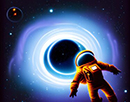
Quantum Complexity Shows How to Escape Hawking’s Black Hole Paradox
Inside of a black hole, the two theoretical pillars of 20th-century physics appear to clash. Now a group of young physicists think they have resolved the conflict by appealing to the central pillar of the new century — the physics of quantum information.
August 2, 2023

The Most Surprising Discoveries in Physics
Experts weigh in on the most shocking, paradigm-shifting and delightful findings in the history of physics
July 27, 2023

Samuel Ting awarded Bhabha Award for AMS work
For “his vision and leadership of the Alpha Magnetic Spectrometer experiment on the International Space Station, which has provided data of unprecedented precision on the spectrum & composition of Galactic cosmic rays that challenge conventional models of their origin.”
July 26, 2023

The dark matter mystery (YouTube Video)
Dark matter is composed of particles that do not absorb, reflect, or emit light, so dark matter is material that cannot be observed directly. We know that dark matter exists because of the effect it has on objects that we can observe directly. But what is it? Why do we need to study it? Watch and learn more about the mystery of dark matter detection.
July 18, 2023

Professor Phil Harris wins 2023 Digital Technology Award
Nominated by students for his use of Jupyter notebooks and open public data in 8.316-Data Science in Physics
June 21, 2023
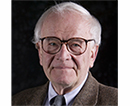
Professor Emeritus Roman Jackiw, “giant of theoretical physics,” dies at 83
Over more than 50 years at MIT, he made fundamental contributions to quantum field theory and discovered topological and geometric phenomena.
June 20, 2023
Photo: Courtesy of the Department of Physics

Life in a hologram
Physicist Daniel Harlow explores an alternate quantum reality in search of fundamental truths to our physical universe.
June 7, 2023
Photo: Gretchen Ertl

How ‘The Legend of Zelda: Tears of the Kingdom’ plays with the rules of physics (Prof. Lindley Winslow)
Link's world is based on our reality, but its natural laws get bent for magic and fun.
May 14, 2023

Eight from MIT elected to American Academy of Arts and Sciences for 2023
The prestigious honor society announces more than 250 new members.
April 24, 2023
Image: Gretchen Ertl

Understanding our place in the universe
Martin Luther King Jr. Scholar Brian Nord trains machines to explore the cosmos and fights for equity in research.
April 12, 2023
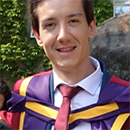
Institute of Physics (IOP) Nuclear Physics Group
Shane Wilkins - Winner of the 2022 Nuclear Physics Group Early Career Award

Daniel Winklehner's Article - Page 14
The IsoDAR Cyclotron and Neutrino Production Target
2022-2023 Annual Newsletter, 19th Edition

Phiala Shanahan is seeking fundamental answers about our physical world
With supercomputers and machine learning, the physicist aims to illuminate the structure of everyday particles and uncover signs of dark matter.
February 28, 2023
Image: Gretchen Ertl

Nine from MIT named 2023 Sloan Research Fellows
Annual award honors early-career researchers for creativity, innovation, and research accomplishments.
February 16, 2023
Photos: Top row, left to right: Luca Carlone, Rafael Gómez-Bombarelli, Jeremy Hahn, and Song Han.
Bottom row, left to right: Erin Kara, Jonathan Ragan-Kelley, Ronald Fernando Garcia Ruiz,
Tobias Salz, and Alison Wendlandt.

Engaging in HEP planning of the future
High Energy Physics or Particle Physics has a long history which you can arguably trace back to the Greeks in 600 BC, where the idea of the atom (atomos – ‘uncuttable’) was first invented in thought experiments.
February 6, 2023

Can you trust your quantum simulator?
MIT physicists have developed a protocol to verify the accuracy of quantum experiments.
January 18, 2023
Image: Jose-Luis Olivares, MIT, with images from iStock

Commons: Wiki Science Competition 2021/Winners/United States
IceCube Neutrino Laboratory at night by John Hardin. (Astronomy)
The ICL during the South Pole winter.

Commons: Wiki Science Competition 2021/Winners/United States
Sastrugi at dawn by John Hardin. (General Category)
A sastrugi, a snow feature formed by wind erosion, that formed over winter at the South Pole.

MIT researchers use quantum computing to observe entanglement
Researchers at the Center for Theoretical Physics lead work on testing quantum gravity on a quantum processor.
December 1, 2022
Image: A. Mueller/inqnet

Daniel Winklehner received the 2022 DPF Instrumentation Early Career Award
For the development of new accelerator technology enabling an order of magnitude increase in the current delivered from a compact proton cyclotron. This work was carried out using artificial intelligence techniques and has enabled the realization of the IsoDAR experiment that will play a decisive role in the search for sterile neutrinos.
November 2022

2022 Stuart Jay Freedman Award in Experimental Nuclear Physics Recipient
For novel studies of exotic nuclei using precision laser spectroscopy measurements, including the first spectroscopy of short-lived radioactive molecules.
September 2022

A new spin on nuclear magnetic moments
New results from researchers at MIT reveal an unexpected feature of atomic nuclei when a “magic” number of neutrons is reached.
July 14, 2022
Image: Adam Vernon

Five with MIT ties win 2022 Hertz Foundation Fellowships
Award provides five years of funding and access to a community of innovative scholars and leaders in science and technology.
July 8, 2022
Photos courtesy of the Hertz Foundation.

3 Questions: Marking the 10th anniversary of the Higgs boson discovery
Christoph Paus, the MIT physicist who co-led the effort to detect the particle, looks ahead to the next 10 years.
June 30, 2022
Image: CERN

Three MIT faculty members named 2022 Simons Investigators
Tracy Slatyer, Jesse Thaler, and Wei Zhang are honored for their research, leadership, and mentorship.
June 24, 2022
Photos courtesy of the departments of Physics

An astrophysicist in a biomedical universe
Magdelena Allen is developing a highly sensitive brain PET scanner that can help answer fundamental questions in neuroscience and particle physics.
June 10, 2022
Photo: Adam Glanzman

Dr. Frank Wilczek Receives 2022 Templeton Prize
Wilczek Joins Past Laureates Mother Teresa and Jane Goodall to Receive One of the World’s Largest Individual Lifetime Achievement Awards
May 11, 2022

“Visualizing the Proton” through animation and film
An art-science collaboration tests the limits of visual technologies.
April 25, 2022
Image: James LaPlante/Sputnik Animation

Nuclear Physics Rap! RESONANCE
MIT Grad student Alex "Brinsino" Brinson raps about research carried out by the CRIS collaboration at ISOLDE, CERN and by EMA lab at MIT.
April 12, 2022

Yen-Jie Lee probes particle collision data for clues to the universe’s origins
The excitement of making discoveries on the global stage is “so much bigger than the pressure,” says the particle physicist.
March 11, 2022
Photo: Bryce Vickmark

Engelhardt named 2022 Sloan Research Fellow
Early-career researchers honored for creativity, innovation, and research accomplishments.
February 16, 2022
Photo courtesy of the researcher

A new upper limit on the mass of neutrinos
Researchers with the KATRIN experiment determine that neutrinos are lighter than 0.8 eV/c2.
February 14, 2022
Photo: Michael Zacher

Scientists make first detection of exotic “X” particles in quark-gluon plasma
The findings could redefine the kinds of particles that were abundant in the early universe.
January 21, 2022
Image: iStockphoto

Kerstin Perez is searching the cosmos for signs of dark matter
“There need to be more building blocks than the ones we know about,” says the particle physicist.
January 2, 2022
Photo: Adam Glanzman

Jesse Thaler: Then and Now / 2011 Early Career Award Winner
WHAT DID THE 2011 EARLY CAREER AWARD ALLOW YOU TO DO?
December 16, 2021

The problem-solver: Cosmic inflation
Just over 40 years ago, a new theory about the early universe provided a way to tackle multiple cosmological conundrums at once.
November 9, 2021
Illustration by Sandbox Studio, Chicago with Tara Kennedy

Taming the data deluge
A National Science Foundation-funded team will use artificial intelligence to speed up discoveries in physics, astronomy, and neuroscience.
October 29, 2021
Photo: Sandi Miller

3 Questions: Investigating a long-standing neutrino mystery
Graduate student Nicholas Kamp describes the MicroBooNE experiment and its implications for our understanding of fundamental particles.
October 28, 2021
Image courtesy of the MicroBooNE Collaboration

Is the Great Neutrino Puzzle Pointing to Multiple Missing Particles?
Years of conflicting neutrino measurements have led physicists to propose a “dark sector” of invisible particles — one that could simultaneously explain dark matter, the puzzling expansion of the universe, and other mysteries.
October 28, 2021

MicroBooNE Results
MicroBooNE's Search for the Low Energy Excess
October 27, 2021
Image courtesy of the MicroBooNE Collaboration

Ronald Garcia Ruiz Received the 2021 Alejandro Ángel Escobar Foundation Prize
Designer Exotic Atoms and Molecules to Unravel the Mysteries of the Universe.
October 22, 2021
Photos courtesy of the faculty

Liu and Winslow named American Physical Society Fellows for 2021
APS names Hong Liu, Lindley Winslow MIT’s newest fellows for their contributions to physics.
October 18, 2021
Photos courtesy of the faculty

Fulwell 73 blasts off for Disney+ NASA series
The six-part series launches on Disney+ on October 6 and features intimate footage, personal video diaries and livestream footage — stationed both on Earth and in space
September 15, 2021

This Physicist Discovered an Escape From Hawking’s Black Hole Paradox
The five-decade-old paradox — long thought key to linking quantum theory with Einstein’s theory of gravity — is falling to a new generation of thinkers. Netta Engelhardt is leading the way.
August 23, 2021
Photo by: Tira Khan for Quanta Magazine

New clues to why there’s so little antimatter in the universe
Radioactive molecules are sensitive to subtle nuclear phenomena and might help physicists probe the violation of the most fundamental symmetries of nature.
July 7, 2021
Image: stock image edited by MIT News

Four MIT faculty members receive 2021 US Department of Energy early career awards
Faculty from the departments of Physics and of Nuclear Science and Engineering faculty were selected for the Early Career Research Program.
June 24, 2021
Photos courtesy of the researchers. Li's photo: Gretchen Ertl

Physicists flip particle accelerator setup to gain a clearer view of atomic nuclei
Shooting beams of ions at proton clouds may help researchers map the inner workings of neutron stars.
March 29, 2021
Image: Jose-Luis Olivares, MIT

Measuring the Invisible
Particle physicist Lindley Winslow seeks the universe’s smallest particles for answers to its biggest questions.
March 24, 2021
Image: M. Scott Brauer

New Frank Wilczek book looks at ten keys to reality
To understand ourselves and our place in the universe, “we should have humility but also self-respect,” the physicist writes in a new book.
January 12, 2021
Image: Christine Daniloff, MIT, stock imagery

Xiaojun Yao on Quantum Computer and the Subatomic Universe
CTP postdoc Xiaojun Yao is in an article about how physicists are exploring quantum computing as a valuable new tool in their quest to understand the subatomic universe.
December 10, 2020
Photo courtesy of CERN

Pulling the secrets of dark matter out of a hat
Grad student Chiara Salemi and Professor Lindley Winslow use the ABRACADABRA instrument to reveal insights into dark matter.
December 2, 2020
Photo: Jon Ouellet

Phiala Shanahan receives Kenneth G. Wilson Award for work in lattice field theory
Recognition honors research into nuclear structure and reactions.
November 18, 2020
Photo courtesy of Phiala Shanahan

No matter the size of a nuclear party, some protons and neutrons will always pair up and dance
Findings on short-range nuclear interactions will help scientists investigate neutron stars and heavy radioactive nuclei.
November 9, 2020
Credit: Collage by MIT News. Neutron star image: X-ray (NASA/CXC/ESO/F.Vogt et al); Optical (ESO/VLT/MUSE & NASA/STScI)

Five MIT researchers receive awards from the American Physical Society
William Barletta, Ronald Fernando Garcia Ruiz, Chanda Prescod-Weinstein, Katelin Schutz, and Phiala Shanahan honored for contributions to physics.
November 4, 2020
Photos courtesy of the researchers

Netta Engelhardt and the Black Hole Information Paradox
The Most Famous Paradox in Physics Nears Its End.
October 30, 2020
Photo courtesy of Netta Engelhardt

Phiala Shanahan Wins Wilson Prize
For excellence in the study of hadrons and nuclei in lattice QCD and for pioneering the application of machine learning and artificial intelligence techniques to lattice field theory.
October 23, 2020
Photo courtesy of Phiala Shanahan

Daniel Harlow awarded Packard Foundation Fellowship
Physics professor receives one of the most prestigious nongovernmental awards for early-career scientists.
October 20, 2020
Photo courtesy of Daniel Harlow

Daniel Harlow wins Packard Fellowship
October 15, 2020 (Los Altos, CA) – Today, the David and Lucile Packard Foundation announced the 2020 class of Packard Fellows for Science and Engineering.
October 15, 2020

Phiala Shanahan wins APS Maria Goeppert Mayer Award
To recognize and enhance outstanding achievement by a woman physicist in the early years of her career, and to provide opportunities for her to present these achievements to others through public lectures in the spirit of Maria Goeppert Mayer.
October, 2020
Photo courtesy of Phiala Shanahan
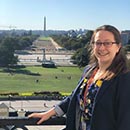
PS Congressional Science Fellow Put Scientific Skills to Use During COVID-19 Crisis
Last fall, after Laura Gladstone began her APS Congressional Science Fellowship with the US Senate Committee on Homeland Security & Government Affairs (HSGAC), she learned that one of her most important projects would be preparing for a hypothetical pandemic.
October, 2020
Photo courtesy of Laura Gladstone

Phiala Shanahan Named Science News Scientist to Watch
This year’s SN 10 scientists aim to solve some of science’s biggest challenges.
September 30, 2020
Photo courtesy of Phiala Shanahan

Provably exact artificial intelligence for nuclear and particle physics
MIT-led team uses AI and machine learning to explore fundamental forces.
September 24, 2020
Image courtesy of the MIT-DeepMind collaboration

Naturally Occurring Radiation Limits Superconducting Qubit Coherence Times
Department of Energy Spotlight
September 18, 2020
Image Courtesy of Michael Perkins, PNNL

Four from MIT awarded 2021 New Horizons in Physics and New Frontiers in Mathematics prizes
Physicists Tracy Slatyer and Netta Engelhardt and mathematicians Lisa Piccirillo and Nina Holden PhD ’18 are honored by the Breakthrough Prize Foundation.
September 10, 2020
Photos: courtesy of the winners

Internet2 Announces Selection of Two Research Teams for Final Phase of Exploring Clouds for Acceleration of Science Project
Investigating Heterogeneous Computing at the Large Hadron Collider, Philip Harris
September 3, 2020

National Science Foundation announces MIT-led Institute for Artificial Intelligence and Fundamental Interactions
IAIFI will advance physics knowledge — from the smallest building blocks of nature to the largest structures in the universe — and galvanize AI research innovation.
August 26, 2020

Can a quantum strategy help bring down the house?
Study finds quantum entanglement could, in principle, give a slight advantage in the game of blackjack.
August 3, 2020
Image: Christine Daniloff, MIT

Four MIT faculty members receive U.S. Department of Energy early career awards
Faculty from the departments of physics, chemical engineering, and mechanical engineering were selected for the 2020 Early Career Research Program.
July 15, 2020
Photos courtesy of the researchers

Nine MIT School of Science professors receive tenure for 2020
Professors earn tenure in the departments of Brain and Cognitive Sciences, Chemistry, Mathematics, and Physics.
July 7, 2020
Image courtesy of the faculty

Daniel Harlow on Why Gravity Is Not LIke the Other Forces
We asked four physicists why gravity stands out among the forces of nature. We got four different answers.
June 15, 2020
Image courtesy of the website

Physicists measure a short-lived radioactive molecule for first time
Molecules containing heavy and deformed radioactive nuclei may help scientists to measure symmetry-violating phenomena and identify signs of dark matter.
May 27, 2020
Image courtesy of the researchers

Exploring the quantum field, from the sun’s core to the Big Bang
Theoretical physicist William Detmold unlocks the mysteries of quarks, gluons, and their “strong interactions” at the subatomic level.
May 13, 2020
Photo: Jared Charney
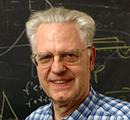
Professor Emeritus Ulrich Becker, who made major contributions to particle physics, dies at 81
Longtime MIT physicist and mentor created instruments that advanced high-energy physics, including the Nobel Prize-winning discovery of the J particle.
April 9, 2020
Photo: Department of Physics

Aron Bernstein, Professor Emeritus of Physics, Dies at 88
Bernstein was a member of the Hadronic Physics Group in the Laboratory for Nuclear Science, and a longtime anti-nuclear weapons activist.
February 3, 2020
Photo courtesy of Bernstein's family

Meet our 2019-2020 winterovers: Yuya and John
Life in Antarctica may sound exciting—and it surely is—but it isn’t all pretty auroras and stargazing.
The USAP Portal: Science and Support in Antarctica - South Pole Station Webcams
The USAP Portal: Science and Support in Antarctica - McMurdo Station Webcams
January 24, 2020

APS 2019 Highlights of the Year
Physics picks its favorite stories from 2019 [Neutrinos Shed Some Weight].
December 16, 2019

Is there dark matter at the center of the Milky Way?
JA new analysis puts dark matter back in the game as a possible source of energy excess at the galactic center.
December 10, 2019
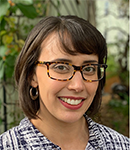
Kerstin Perez, One of 10 Early-Career Physicists
Junior faculty in experimental particle physics and astrophysics talk about how they got into physics, their favorite parts of the experimental process and how they spend their time outside the lab.
November 26, 2019

American Physical Society honors three MIT professors for physics research
James Collins, Pablo Jarillo-Herrero, and Richard Milner have won top prizes for their work.
October 24, 2019
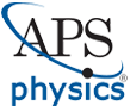
Richard G. Milner is awarded the 2020 Tom W. Bonner Prize in Nuclear Physics
For pioneering work developing and using polarized internal targets in storage rings and his leadership role in studying the structure of the nucleon in a wide range of electronuclear experiments.
October 22, 2019

Four from MIT named American Physical Society Fellows for 2019
Matthew Evans, Joseph Formaggio, Markus Klute, and Anne White are named MIT’s newest APS fellows for their contributions to physics.
September 20, 2019
Photos courtesy of the researchers (Bryce Vickmark for Anne White)

3Q: Scientists shave estimate of neutrino’s mass in half
Joseph Formaggio explains the discovery that the ghostly particle must be no more than 1 electronvolt, half as massive as previously thought.
September 16, 2019
Image: The KATRIN Collaboration

In Memoriam
Dave Luckey's Obituary
A full account of his scientific career can be found in his Physics Today obituary
online at https://physicstoday.scitation.org/do/10.1063/PT.6.4o.20190826a/full/

Engelhardt honored with prestigious 2019 Blavatnik Regional Award for Young Scientists
Winning postdoctoral scientists include a neuroscientist researching mosquito feeding habits, a theoretical physicist investigating the relationship between quantum gravity and black holes...
September 4, 2019
Image: Fermilab

Richard Milner's Visualizing the Proton
Physicists have developed the “Standard Model” that successfully explains atomic structure.
August 23, 2019

Physicists design an experiment to pin down the origin of the elements
Prototype machine-learning technology co-developed by MIT scientists speeds processing by up to 175 times over traditional methods.
August 20, 2019
Image: NASA/ESA/Hubble

Boosting computing power for the future of particle physics
Prototype machine-learning technology co-developed by MIT scientists speeds processing by up to 175 times over traditional methods.
August 19, 2019
Image: Fermilab

Data-mining for dark matter
Tracy Slatyer hunts through astrophysical data for clues to the invisible universe.
August 15, 2019
Image: Bryce Vickmark
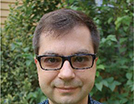
EIC Center at Jefferson Lab Announces Fellowship Awards
The Electron-Ion Collider Center at the Department of Energy’s Thomas Jefferson National Accelerator Facility (EIC Center at Jefferson Lab) has announced the winners of four fellowships to pursue research over the next year related to a proposed electron-ion collider to be located in the United States. The Center advances and promotes the science program of a future EIC facility.
August 7, 2019

Daniel Freedman wins Special Breakthrough Prize in Fundamental Physics
MIT professor emeritus will share $3 million prize with Sergio Ferrara and Peter van Nieuwenhuizen for discovery of supergravity.
August 6, 2019
Image courtesy of Daniel Freedman

Seeking new physics, scientists borrow from social networks
Technique can spot anomalous particle smashups that may point to phenomena beyond the Standard Model.
July 25, 2019
Image: Chelsea Turner, MIT

Meet the 2019 tenured professors in the School of Science
Eight faculty members are granted tenure in five science departments.
July 10, 2019
Photos courtesy of the faculty

2019 Stuart Jay Freedman Award in Experimental Nuclear Physics Recipient
Or Hen - Massachusetts Institute of Technology
July 2019

Seven MIT faculty win 2019 Presidential Early Career Awards
Checkelsky, Chung, LeBeau, Lee, Marelli, Slatyer, and Surendranath receive the highest U.S. award for young scientists and engineers.
July 10, 2019

Hong Liu wins a John Simon Guggenheim Fellowship
Hong Liu is a theoretical physicist at the Center for Theoretical Physics. His research lies at the interface of string theory/quantum gravity, nuclear physics, and condensed matter physics.
John Simon Guggenheim Memorial Foundation 2019 Fellows - United States and Canada
April 16, 2019
Photo: Courtesy of the researcher

Dark matter experiment finds no evidence of axions
In its first run, ABRACADABRA detects no signal of the hypothetical dark matter particle within a specific mass range.
March 29, 2019
Photo: Courtesy of the researchers
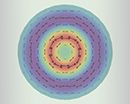
Physicists calculate proton’s pressure distribution for first time
The particle’s core withstands pressures higher than those inside a neutron star, according to a new study.
February 22, 2019
Photo: Courtesy of the researchers

Four from MIT named 2019 Sloan Research Fellows
Nikhil Agarwal, Daniel Harlow, Andrew Lawrie, and Yufei Zhao receive early-career fellowships.
February 21, 2019
Photo: (l-r) Courtesy/Justin Knight/Allegra Boverman/
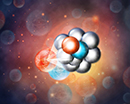
Study of quark speeds finds a solution for a 35-year physics mystery
Number of proton-neutron pairs determine how fast the particles move, results suggest.
February 20, 2019
Photo: Courtesy of the researchers

From summer research program to PhD dissertation
Graduate student Raspberry Simpson’s scientific journey approaches fruition.
February 15, 2019
Photo: Gretchen Ertl

2019 J.J. and Noriko Sakurai Dissertation Award in Theoretical Particle Physics Recipient
Nick Rodd becomes 3rd CTP student in 4 years to win APS Sakurai Dissertation Prize.
November 20, 2018

Not your Standard Model physicist
Professor Janet Conrad is on a quest to find the elusive “ghost” particle—and turn physics on its head.
October 23, 2018

Physicist Takes Cues from Artificial Intelligence
Cristiano Fanelli has been awarded the 2018 JSA Postdoctoral Prize for innovative solutions in optimizing particle detectors.
October 22, 2018

Evans, Barsotti and Harlow Win 2019 Breakthrough New Horizons Prize
Four other MIT researchers to receive New Horizons Prizes in math and physics; two alumni win Breakthrough Prize in Fundamental Physics.
October 17, 2018
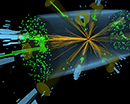
Center for Theoretical Physics professors earn DOE Quantum Information Science Awards
Professors Daniel Harlow, Aram Harrow, Hong Liu, and Jesse Thaler among the first recipients of new honor for advances in quantum understanding.
October 12, 2018
Image courtesy of the Laboratory for Nuclear Science

School of Science Welcomes 10 Professors
New faculty join the departments of Biology, Brain and Cognitive Sciences, Chemistry, Physics, Mathematics, and Earth, Atmospheric and Planetary Sciences.
September 19, 2018
Image courtesy of the School of Science
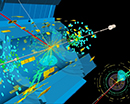
3 Questions: Philip Harris on First Observation of Long-predicted Higgs Boson Decay
Seeing Higgs boson decay required “magic-eye” focus; may help physicists understand why the universe has mass.
August 28, 2018
Image: ATLAS Collaboration/CERN

Four Honored with School of Science Teaching Prizes
Moitra, O’Gorman, Perez, and Minicozzi were nominated by students and colleagues for demonstrating excellence in instruction.
August 20, 2018
Image courtesy of the School of Science
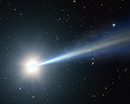
Light From Ancient Quasars Helps Confirm Qantum Entanglement
Results are among the strongest evidence yet for “spooky action at a distance.”
August 19, 2018
Image: NASA/ESA/G.Bacon, STScI
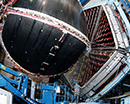
In Neutron Stars, Protons May Do the Heavy Lifting
The positively charged particles may have an outsize influence on the properties of neutron stars and other neutron-rich objects.
August 13, 2018
Photo: Courtesy of the researchers
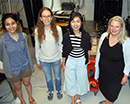
Paying it Forward: Fellowship Boosts Women in Physics
Four students are first beneficiaries of grant program established by Assistant Professor Lindley Winslow with support from the Heising-Simons Foundation.
August 2, 2018
Photo: Sandi Miller
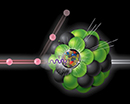
3Q: Richard Milner on a new U.S. Particle Accelerator
Proposal for powerful particle collider gets National Academies’ go-ahead.
July 24, 2018
Image: Brookhaven National Laboratory
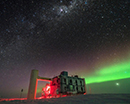
New Study Again Proves Einstein Right
Most thorough test to date finds no Lorentz violation in high-energy neutrinos.
July 16, 2018
Image: Martin Wolf, IceCube/NSF
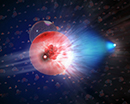
3Q: Janet Conrad on the First Detection of a Neutrino’s Cosmic Source
The “ghostly particle” is confirmed to have originated from a blazar, nearly 4 billion light years from Earth.
July 13, 2018
Image: Nicolle R. Fuller/NSF/IceCube
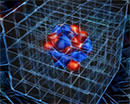
Project to Elucidate the Structure of Atomic Nuclei at the Femtoscale
Laboratory for Nuclear Science project selected to explore machine learning for lattice quantum chromodynamics.
July 6, 2018
Photo courtesy of
Laboratory for Nuclear Science

UALCF selects data and learning projects for Aurora Early Science Program - Machine Learning for Lattice Quantum Chromodynamics (W. Detmold)
Machine Learning for Lattice Quantum Chromodynamics
June 27, 2018
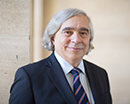
3Q: Ernest Moniz on the Vatican Climate Dialogue
Professor emeritus and former U.S. energy secretary reflects on recent meeting with Pope Francis and energy and finance leaders.
June 12, 2018
Photo: Bryce Vickmark
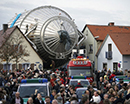
Pinning Down a Neutrino’s Mass
KATRIN experiment investigates the ghostly particle.
June 8, 2018
Image: Karlsruhe/KIT Katrin
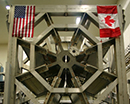
Understanding the Proton's Weak Side
Research from the Qweak experiment provides a precision measurement of the proton’s weak charge. narrows the search for new physics.
May 10, 2018
Photo courtesy of
Laboratory for Nuclear Science
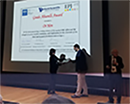
Or Hen
Receives 2018 Guido Altarelli Award
Assistant professor of physics and Laboratory for Nuclear Science researcher recognized for major contributions to high energy and nuclear physics.
April 18, 2018
Photo courtesy of Or Hen
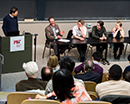
Center for Theoretical Physics Celebrates 50 Years
Symposium explores how novel ideas and experiments are advancing many areas of theoretical physics in newly interconnected ways.
March 28, 2018
Photo: Justin Knight
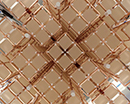
Scientists Report First Results from CUORE Neutrino Experiment
Data could shed light on why the universe has more matter than antimatter.
March 26, 2018
Image: CUORE Collaboration
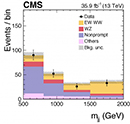
MIT Physicists Observe Electroweak Production of Same-sign W Boson Pairs
With the aid of the Compact Muon Solenid detector at the Large Hadron Collider, a Laboratory for Nuclear Science-led group seeks to further understand the building blocks of matter.
February 27, 2018
Image: Markus Klute

LHCb (Mike Williams and collaborators) Searches for Dark Photons: Phys Rev Letters and CERN Courier
Synopsis: LHC Sees No Dark Photons
A search for dark photons at the LHC comes up empty but puts new constraints on the strength of the hypothetical particles’ coupling to electromagnetic fields...
February 8, 2018
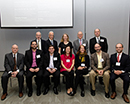
Bose Grants for 2017 Reward Bold and Unconventional Research Visions
Six potentially paradigm-shifting research projects will make strides with funding from Professor Amar G. Bose Research Grants.
December 14, 2017
Photo: John Gillooly
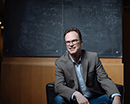
Jesse Thaler: Seeking the Fundamental Nature of Matter
Theorist explores particle physics at the boundary of “messy and elegant.”
November 7, 2017
Photo: Jared Charney
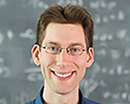
Aram W. Harrow Recipient of the 2018 Rolf Landauer and Charles H. Bennett Award in Quantum Computing
This award recognizes recent outstanding contributions in quantum information science, especially using quantum effects to perform computational and information-management tasks that would be impossible or infeasible by purely classical means.
October 31, 2017

Bridging the Science-Policy Divide
For MIT senior Talia Weiss, physics and theater have provided a springboard for new interests in political science.
October 17, 2017
Photo: Ian MacLellan
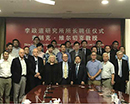
Wilczek Appointed Founding Director of the Tsung-Dao Lee Institute
Nobel Laureate, Frank Wilczek is Herman Feshbach Professor of Physics at MIT, Founding Director of the Tsung-Dao Lee Institute (TDLI)...
October 17, 2017
Photo: Ian MacLellan
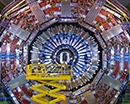
First Open-Access Data from Large Collider Confirm Subatomic Particle Patterns
CERN Open Data Portal results reveal predictable patterns from colliding high-energy protons.
September 29, 2017
Photo courtesy of CERN
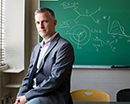
Particle Hunter (Markus Klute)
Now that the Higgs boson has come to light, Markus Klute is looking at physics beyond the Standard Model.
July 21, 2017
Photo: M. Scott Brauer
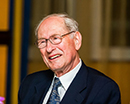
Arthur Kerman, Professor Emeritus of Physics, dies at 88
Former Laboratory for Nuclear Science and Center for Theoretical Physics director made important contributions to the study of nuclear structure and reactions.
June 2, 2017
Photo: Justin Knight

Tracy Slatyer Wins Future of Science Award
Tracy Slatyer, the Jerrold R. Zacharias Career Development Assistant Professor of Physics, has been named the first recipient of the School of Science’s Future of Science Award.
May 18, 2017
Photo courtesy of the
Department of Physics
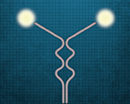
Proton Structure Comes to Light (OLYMPUS)
The OLYMPUS collaboration has found evidence of two-photon exchange, a process that could reconcile discrepant measurements of the proton’s inner construction.
March 20, 2017
Photo: Christine Daniloff/MIT
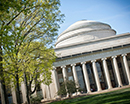
Kerstin Perez was named as a Sloan Fellow
Faculty from four MIT departments among 126 selected from across the U.S. and Canada.
February 21, 2017
Photo: Patrick Gillooly




